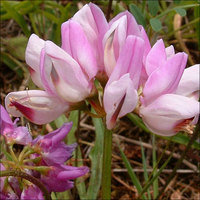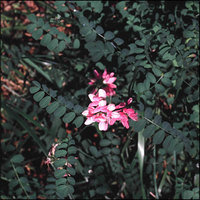





Brought from Europe to North America in the 1950s, crown vetch quickly outlived its welcome. The aggressive plant is fairly attractive, and performs well as ground cover, but use it with care.
(Editor's Note: This article was originally published on May 18, 2009. Your comments are welcome, but please be aware that authors of previously published articles may not be able to respond to your questions.)
Crown vetch (Coronilla varia) is sometimes called axseed, axwort, hive-vine, or trailing crownvetch. To add to the confusion, it is sometimes referred to as Securigera varia. University of Missouri Extension considers the plant not a true vetch. Regardless of what name is preferred, crown vetch has landed on the list of unwelcome aggressive species in many northeastern states and parts of southern Canada.
Originally imported to use for groundcover, it was quickly discovered that this member of the pea family (formerly Leguminosae, now Papilionaceae) was excellent for erosion control on slopes, soil rehabilitation, and roadside planting. Given free rein in nature, the plant adapted to all soil and environmental conditions. However, with care, crown vetch can be utilized in the landscape to provide attractive, no-maintenance ground cover for areas that are impossible to mow or maintain. In any instance, be sure this species is not planted in an area where it can spread to cultivated parts of the property. Also be aware that the plant is attractive to deer, as this is a natural forage for them.
Pretty AND Hardy
Crown vetch is a low-growing vine with a creeping stem that grows to less than 2 feet. Pink to rose to lilac pea-like flowers bloom in umbrel form from June through September, depending on region. The plant can be confused with partridge pea (Cassia fasciculata), other native vetches, and non-native pea family relatives.
Some of the reasons this plant has naturalized so widely is its high tolerance for many conditions:
 The above list also shows why crown vetch can be a good addition to areas like slopes around buildings or driveways, lawns too steep for mowing, and similar situations, but the plant is a slow starter in initial application, taking from 2 to 5 years to fully establish. It can also be seriously damaged if mowed frequently.
The above list also shows why crown vetch can be a good addition to areas like slopes around buildings or driveways, lawns too steep for mowing, and similar situations, but the plant is a slow starter in initial application, taking from 2 to 5 years to fully establish. It can also be seriously damaged if mowed frequently.
The subject of toxicity has a wide range of opinions and studies. Several resources stated that crown vetch posed a threat to horses, but that cattle could ingest it without consequences. Nowhere in the literature was the mention of toxicity to humans. Another source stated that crown vetch grew in a large horse pasture, but that the animals avoided it.
Using Crown Vetch in the Landscape
If crown vetch is the choice for inclusion in the landscape, it is available by either seed or peat-potted plants; both sources are relatively high in price ($50 for 30 plants/$17 for 1/4 pound seed).[1] Three varieties are available: 'Emerald', 'Penngift', and 'Chemung'. 'Emerald' and 'Chemung' are the most vigorous of the three, and they usually have taller growth. 'Emerald' is suitable for conditions in the Midwest, and 'Chemung' prefers the low fertility areas of the Northeast.
Planting crown vetch is more challenging than other species. The seed will not grow unless inoculated with a specific strain of bacteria. The microorganism attaches to the roots of the plant and captures nitrogen, degrades it, then supplies it to the plant. Seeds ordered from commercial companies will include a package of the inoculant and instructions.
Proper soil preparation and amendment is crucial to this legume; it will not establish on unlimed soils. Lime and fertilizer are worked into an uneven and rough seedbed; leave rocks, large clods, and even stumps to help stabilize the soil. Good contact with the soil is critical to seed germination. Mulch is recommended as young plants establish. Straw, cheesecloth, used tobacco canvas, woodchips or woodbark would all be adequate. Crown vetch can be incorporated into an area where vegetation is thin and sickly. Scratch the surface with a rake to provide soil contact for the seeds. For detailed instructions and ratios, read this excellent article from the University of Kentucky Department of Agronomy.
Peak times to establish crown vetch are mid-February through the end of March, or mid-August through mid-September. Any time in between will stress the seedling through heat, drought, and weed competition. Too late in the season, the plants will not survive the winter. Got Vetch?
Got Vetch?
If you have this wildly spreading plant in places you don't want it, it can be easily controlled by pulling the mature plants. If the location is too large for hand-weeding, mowing the plants at the flower stage for 2 to 3 consecutive years might control further spread. Just be sure to mow before the seeds mature.
Still discussing small areas of invasives, use of Glyphosate, triclopyr, or metsulfuron will effect control, as long as they are applied during active growth. Remember that triclopyr (Weed-B-Gone, Brush-B-Gone) is selective for broadleaf plants and will not harm adjacent grasses. Glyphosate (Roundup) will kill anything it touches. As always, read the label thoroughly and use good chemical-use practices.
For control in larger areas such as pastures, fields, and naturalized prairies, consult your local extension agent for best practices and products.
[1] Prices found on Gurneys.com February 2009
Sources:
University of Missouri Extension. http://extension.missouri.edu
University of Kentucky Department of Agronomy. "Slope Stabilization with Crown Vetch", A.J. Powell, Jr.
Southeast Exotic Pest Plant Council. http://www.invasive.org
The Ohio State University. "Ohio Perennial & Biennial Weed Guide". http://www.oardc.ohio-state.edu/weedguide
First 2 photos: Wikimedia Commons, GNU Licenses
Third photo courtesy Ohio State Weed Lab Archives, Ohio State University
Copyright © www.100flowers.win Botanic Garden All Rights Reserved